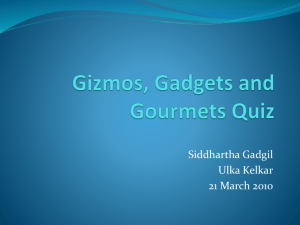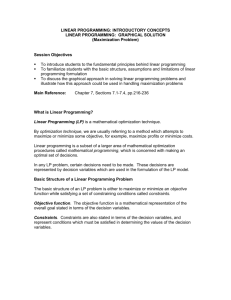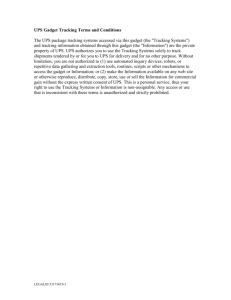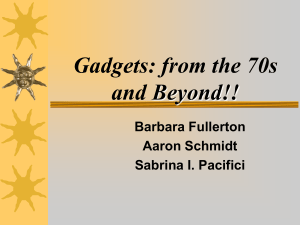Lecture 5 Scribe Notes 1
advertisement
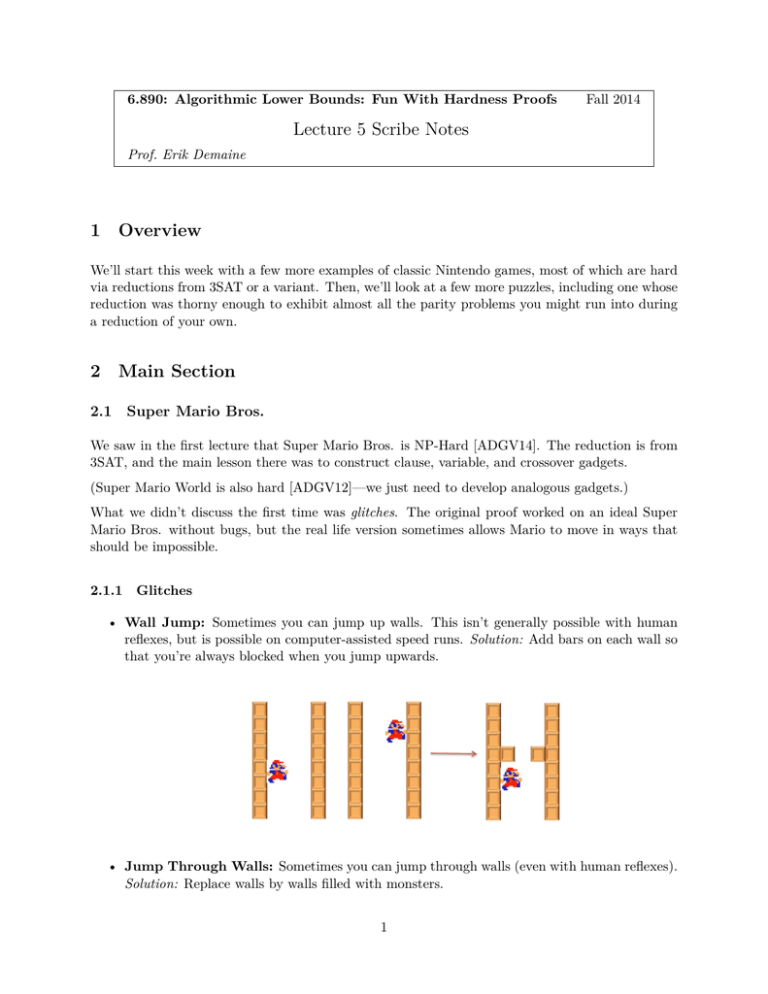
6.890: Algorithmic Lower Bounds: Fun With Hardness Proofs
Fall 2014
Lecture 5 Scribe Notes
Prof. Erik Demaine
1
Overview
We’ll start this week with a few more examples of classic Nintendo games, most of which are hard
via reductions from 3SAT or a variant. Then, we’ll look at a few more puzzles, including one whose
reduction was thorny enough to exhibit almost all the parity problems you might run into during
a reduction of your own.
2
Main Section
2.1 Super Mario Bros.
We saw in the first lecture that Super Mario Bros. is NP-Hard [ADGV14]. The reduction is from
3SAT, and the main lesson there was to construct clause, variable, and crossover gadgets.
(Super Mario World is also hard [ADGV12]—we just need to develop analogous gadgets.)
What we didn’t discuss the first time was glitches. The original proof worked on an ideal Super
Mario Bros. without bugs, but the real life version sometimes allows Mario to move in ways that
should be impossible.
2.1.1 Glitches
• Wall Jump: Sometimes you can jump up walls. This isn’t generally possible with human
reflexes, but is possible on computer-assisted speed runs. Solution: Add bars on each wall so
that you’re always blocked when you jump upwards.
• Jump Through Walls: Sometimes you can jump through walls (even with human reflexes).
Solution: Replace walls by walls filled with monsters.
1
2.2 Legend of Zelda
Most Zelda games contain a block-pushing puzzle, so they’re hard by standard block pushing results.
(In fact, Zelda’s block pushing is a little more constrained. It’s called Push-Once: not only can
you only push one block at a time, but you can only push a block once. The lock mechanism from
Push-1 can be modified for a Push-Once environment, so Push-Once is also hard.)
Figure 1: The modification of the Push-1 lock to the Push-Once lock prevents Link from pushing
a block more than once (assuming Link does not have a raft) because blocks can’t be pushed into
the water.
However, it would be nice to give a Legend of Zelda reduction that doesn’t follow directly from
block-pushing, and in fact such a reduction exists, so Legend of Zelda is NP-Hard [ADGV12]. The
reduction uses a Zelda item called a hookshot, which allows the player to jump over holes as long
as there’s an object on the other side; the reduction from 3SAT requires creating variable, clause,
and crossover gadgets, as haul.
2
Figure 2: The variable gadget lets Link hookshot from the chests in the center to either of the
chests on the bottom. Link can push any of the blocks down so that he can later hookshot from the
left. Finally, the crossover gadget only allows Link to hookshot to chests that are directly across.
2.3 Metroid
Metroid is NP-complete [ADGV14]. The variable gadgets work just as they do in Super Maro
Bros.; activating a variable in a clause gadget allows the player to kill all the enemies who would
otherwise block her path to finishing the level. The crossover gadget involves a well-timed group of
enemies that cycle around the gadget—a player only has time to cross in one direction and would
be killed by turning onto a forbidden path. See the paper for more details!
Figure 3: The clause gadget allows Samus to come through one of the tunnels below the monsters
and shoot up to kill them. However, if she came from the top path, then there is nothing she could
do because she can’t shoot down. The cross over gadget allows her to either come from the left
or right. Depending on which tunnel she chose she has to either roll left or roll right to avoid the
monsters that are moving in opposite directions.
Remark: We actually claim NP-completeness for Metroid because the states are simple enough
to be described in polynomial time. Most of the other problems in this lecture may not be in NP
because verifying a certificate could take too long.
3
2.4 Donkey Kong Country
Donkey Kong Country is NP-Hard [ADGV12]. By now, the reduction is familiar: variable gadgets
involve exclusively choosing a true or false paths; clause gadgets allow the player to remove an
obstruction (in this case, a bee), which would otherwise block her path to the exit. The crossover
gadget in Donkey Kong Country is a cross of four shooter barrels: since the player cannot control
Donkey Kong while he’s in the air, players can use crossover gadgets only for the intended paths.
Figure 4: Donkey Kong picks up a barrel to kill the bee to later traverse the path in the clause
gadget. Then, for the crossover gadget, the roll forward and backward barrel prevents the vertical
path from leaking into the horizontal path and vice versa.
2.5 Pokemon
“Pokemon is a somewhat complicated game.” In the reduction considered in [ADGV14], there
are weak trainers and strong trainers. The player always wins against weak trainers and always
loses against strong trainers. Trainers you’ve beaten (all weak trainers, of course) act as obstacles
for strong trainers once they’re activated. Satisfying a clause corresponds to activating several
barrier trainers, which allow the player to exit all clause gadgets if and only if they’re all satisfied.
(We imagine that trainers have a larger field of vision than they do in the real game, though the
reduction still requires only a bounded constant range.) With this setup, Pokemon is NP-Hard.
4
Figure 5: Variable, clause, and crossover gadget. The purpose of the clause gadget is to come down
from the top and eliminate one of the red trainers in advance.
Erik would like to establish his Pokemon cred, so he read us this slide: “Weak Trainers each hold a
Level 100 Electrode with maximum Speed and equipped with only the Self Destruct move. Strong
Trainers each hold two Snorlaxes, with Speed of 30. The player has no items, and only one Pokémon
in his team. For Generation I and II games (Red/Blue/ Yellow and Gold/Silver/Crystal versions
respectively), the player holds a Gastly which has learned Self Destruct using TM36, and its PP
for its other moves have all been expended, so it can only use Self Destruct in battle. When the
player encounters a weak Trainer, the enemy Electrode will move first and use Self Destruct, which
deals no damage to Gastly since Self Destruct is a Normal type attack and Gastly is Ghost type, so
the weak Trainer immediately loses. When the player encounters a strong Trainer, Gastly moves
first and uses Self Destruct, causing the player to lose (even if it defeats the enemy Snorlax, the
opponent holds another one). This implementation only works in Generations I and II since TM36
exists only in Generation I and the Time Capsule feature in Generation II allows a Gastly with Self
Destruct to be traded from Generation I to Generation II. In Generations III, IV, and V, Gastly
can be replaced by Duskull, which is allowed to learn the move Memento, which serves the same
purpose as Self Destruct, via breeding.”
5
2.6 Conway’s Phutball (Philosopher’s Football)
Phutball is a 2-player game played with black and white stones on a square lattice (or Go board).
Players move by either adding another black stone to the board or moving the white stone by
jumping over contiguous groups of black stones and removing them. The goal is to move white
stone to one of the goals at the end of the board.
This game is not solved, and a large class of problems are still unsolved. The game is PSPACE-hard
[Der10] and even a simple problem such as deciding whether a current position is a mate-in-1 is
NP-complete [DDE02]. Whether the game is EXPTIME-complete is still open.
The reduction in [DDE02] lays out variables and clauses on a large 2-dimensional board, with
variable choices along the left and right edge and clauses along the top and bottom. The player
makes a series of long horizontal jumps to choose which variables to set to true, and is able to
traverse top to bottom if and only if none of the crucial squares have been cleared.
Figure 6: Here clauses are traversed by going top to bottom or bottom to top. Variable values are
set by going left to right and vice versa.
One heuristic for understanding why even this simple question is NP-complete is that one move in
phutball can comprise a large number of individual jumps. However...
2.7 Checkers
Checkers mate-in-1 also seems to involve a large number of jumps, but deciding whether a checkers
position is a mate-in-1 is in P: the problem reduces to the question of finding an Eulerian path on
6
a graph, which is very easy to decide [FGJ+ 78]
Figure 7: We can rotate the board by 90 degrees and now jumps are vertical and horizontal. All
horizontal and vertical jumps preserve x and y parity.
2.8 Cryptarithms/Alphametrics
Cryptarithms are classic puzzles involving arithmetic on words.
+
M
S
M
O
E
O
N
N
R
E
D
E
Y
Table 1: The SEND MORE MONEY Cryptarithm.
The goal is to find a bijection between letters and numbers making the arithmetic operations
correct. 1
Cryptarithms are NP-complete [Eps87], which Epstein showed by reducing from 3SAT. (We have
to allow numbers with a large base, but with that proviso the problem is strongly NP-complete.)
Variables and clauses correspond to contiguous sets of columns, with the rightmost three columns
reading:
0p0
0p0
1q0
These three columns force the letter “0” to have the value 0 and the letter “1” to have the value 1.
A variable va is considered true if va = 1 (mod 4) and false if va = 0 (mod 4)—the variable gadget
1
For the puzzle in Table 1, S = 9, E = 5, N = 6, D = 7, M = 1, O = 0, R = 8, Y = 2.
7
sets both va and its opposite va . This is accomplished through a string of intermediate sums:
bi = 2ai
C = carry(yi + yi ) E {0, 1}
vi = 2bi + C
= 4ai + C = C
(mod 4)
di = 2ci + C
ei = di + 1 + C
= 2ci + 1 + 2C
vi = di + ei
= 4ci + 1 + 3C
di
ei
vi
= 3C + 1 = 1 − C
(mod 4)
0
0
0
yi
yi
zi
1
di
ei
0
0
0
yi
yi
zi
ci
ci
di
0
0
0
bi
bi
vi
yi
yi
zi
0
0
0
ai
ai
bi
0
0
0
Table 2: The variable gadget.
A clause gadget is a string of columns that checks whether the sum of three variables is congruent
to 1, 2, or 3 modulo 4; if it is, then one of the variables was true.
uab
vc
ti
0
0
0
va
vb
uab
0
0
0
1
hi
ti
ri
ri
si
0
0
0
gi
gi
hi
wi
wi
xi
0
0
0
fi
fi
gi
0
0
0
Table 3: The clause gadget.
gi = 2fi
hi = 2gi + {0, 1}
= 4fi + {0, 1}
ti = hi + 1 + {0, 1}
= 4fi + 1 + {0, 1, 2}
= 4fi + {1, 2, 3}
va + vb + vc = ti = {1, 2, 3}
(mod 4)
This construction can be simplified considerably by instead reducing from 1-in-3SAT, which is still
NP-complete. We don’t need negations anymore, and we can then check a clause by seeing whether
its three variables sum to 1 (mod 4):
8
gi = 2fi
hi = 2gi
= 4fi
ti = h i + 1
= 4fi + 1
va + vb + vc = ti = 1 (mod 4)
It’s easy to check that a solution to the cryptarithms gives a solution to 3SAT, but the reverse is
less clear: we still need a way to assign the letters in a distinct fashion. In particular, we would
like to set vi and vi such that the sums vi + vj + vk are all distinct. We can show inductively
that a polynomial number of values suffice; we assign the vi in order of the index i, selecting vi to
avoid the situation where vi = vj + vk + vl − vm − vp , for j, k, l, m, p < i. Since there are only n5
such quintuples, as long as we have more than n5 numbers it will always be possible to select a vi
satisfying this condition.
Since the parameters remain polynomial, this construction proves that cryptarithms are strongly
NP-hard.
2.9 Star Tessellation
Deciding whether a crease pattern has a flat folded state is NP-hard [BH96]. The easy part is
deciding where the polygons in a folding pattern end up in the plane; the difficult part is deciding
which pieces of paper lie atop others.
Figure 8: Some crease patterns are legal while others are not. If the creases locally intersect, then
the pattern is illegal because a piece of paper can’t both be on top and under itself.
We build our reduction out of pleats (two parallel segments). Two parallel creases can’t both be
“mountains” or both be “valleys,” because then the paper would locally self-intersect, so there has
to be one fold of each type. Variables will correspond to orientations of pleats.
9
Figure 9: Pleats represent different variables. Depending on which crease is a mountain and which
is a mountain fold and which is a valley fold, we can represent True or False.
A triangular twist is the intersection of three pleats in such a way that the twist can only be folded
if the pleats are not all oriented the same direction. This is a Not-All-Equal gadget.
Figure 10: Arrows within the triangular gadget all point into the gadget. Because not all of the
folds pointing into the center of the gadget are the same, we can produce a flat fold. However, if
they are all the same, then we can’t produce a flat fold because each fold of the paper is on top of
another.
Remark: A nice reason to hope for a reduction from Not-All-Equal-3SAT is that “true” and
“false” are totally symmetric in origami, and Not-All-Equal-3SAT is a totally symmetric formulation
of satisfiability.
Checking that these folds can be represented polynomially is a little tricky, but serves to establish
that the problem is in NP.
The splitter/negation gadget forces a fold to be false if another fold next to it is true.
10
Figure 11: Splitter/negation gadget.
The crossover gadget makes sure that a fold can fold one way or another without being able to fold
both ways.
Figure 12: Crossover gadget.
The reduction is from Not-All-Equal-SAT: a triangle of folds represents a clause, and it is foldable
if and only if the three incoming folds are not all of the same type. We can represent negations
using the splitter gadget and the crossover gadget prevents folds from crossing themselves. For
more, see [DO07].
2.10
Vertex-Disjoint Paths
The Vertex-Disjoint Paths problem asks, given a graph G and a set of starting and ending points,
are there paths between each pair not sharing any vertices?
Vertex-Disjoint Paths is NP-complete [Lyn75], and it’s very easy to prove: there are horizontal
pairs—variable gadgets—and there are exactly two paths between each pair, one true and one false.
Clause pairs are vertical, and there are three paths between clause pairs, each one corresponding
to a “satisfying” path.
11
Figure 13: Clauses are vertical and variables horizontal.
This construction can also be carried through even if we require that G be planar by designing
crossover gadgets for edges. Crossover gadgets force you to either take one path or the other.
Figure 14: Crossover gadget forces you to take either the red or blue path. Switching paths results
in a cross and visiting a vertex more than once.
There is another planar problem, Vertex-Disjoint Paths in a Rectangle. In this problem, we require
that every square of our grid be occupied by a path (and that the graph be planar). This problem
is NP-complete [ADO+ 14].
Erik just completed this proof recently, so he’s going to show us some of what can go wrong in a
proof like this. The problem was designing the crossover gadget, which is necessary for ensuring
the graph’s planarity.
2.10.1 What Can Go Wrong
• In order for a region to be fillable, it needs to have an even number of terminals. But Erik’s
original construction left an odd, unpaired terminal.
12
Figure 15: Empty space parity.
• The original gadget was designed by considering the case where a path needed to pass from
left to right or right to left. But sometimes a path won’t go through a gadget at all, and it
still needs to be fillable in that case. This caused another parity problem, which was solved
by adding another line of dots.
Figure 16: Clause path may be absent.
• Once the gadgets were constructed properly, there was the issue of fitting them together.
But the sizes of the variable gadgets and crossover gadgets were inconsistent—another parity
problem!
Figure 17: Gadget size parity.
13
• Once the full crossover versions were completed, it was necessary to create versions which
managed to bock edges of a specified type. These were accomplished by adding small terminal
pairs to the crossover gadget.
Figure 18: Crossing versions.
2.10.2 Origins
A version of this problem appeared as “The Puzzled Neighbors,” created by Sam Loyd for the
Brooklyn Daily Eagle in 1897. However, Erik’s motivation was the Japanese puzzle Numberlink,
by Nikoli, which can be found under the name Flow Free on the Android store. There is some
disagreement about the precise rules of the game. The paper [ADO+ 14] considers a variant called
Zig-Zag Numberlink; another version, “Classic,” was considered in 2010 and is also hard [KT10].
References
[ADGV12] Greg Aloupis, Erik D Demaine, Alan Guo, and G Viglietta. Classic Nintendo games
are (NP-) hard. arXiv preprint arXiv:1203.1895, 2012.
[ADGV14] Greg Aloupis, Erik D Demaine, Alan Guo, and Giovanni Viglietta. Classic Nintendo
games are (computationally) hard. In Fun with Algorithms, pages 40–51. Springer, 2014.
[ADO+ 14] A Adcock, E D Demaine, M P O’Brien, F Reidl, F Sánchez Villaamil, and B D Sullivan.
Zig-Zag Numberlink is NP-complete. Under review, 2014.
[BH96]
Marshall Bern and Barry Hayes. The complexity of flat origami. In Proceedings of the
seventh annual ACM-SIAM symposium on Discrete algorithms, pages 175–183. Society
for Industrial and Applied Mathematics, 1996.
[DDE02] Erik D Demaine, Martin L Demaine, and David Eppstein. Phutball endgames are hard.
More Games of No Chance, 42:351, 2002.
[Der10]
Dariusz Dereniowski. Phutball is PSPACE-hard. Theor. Comput. Sci., 411(44-46):3971–
3978, 2010.
14
[DO07]
Erik D Demaine and Joseph O’Rourke. Geometric folding algorithms. Cambridge
university press Cambridge, 2007.
[Eps87]
D Epstein. On the NP-completeness of cryptarithms. ACM SIGACT News, 18(3):38–40,
1987.
[FGJ+ 78] Aviezri S Fraenkel, MR Garey, David S Johnson, T Schaefer, and Yaacov Yesha. The
complexity of checkers on an n× n board. In Foundations of Computer Science, 1978.,
19th Annual Symposium on, pages 55–64. IEEE, 1978.
[KT10]
古妻浩一 and 武永康彦. ナンバーリンクの NP 完全性と問題の列挙. 電子情報通信学
会技術研究報告. COMP, コンピュテーション, 109(465):1–7, 2010.
[Lyn75]
James F Lynch. The equivalence of theorem proving and the interconnection problem.
ACM SIGDA Newsletter, 5(3):31–36, 1975.
15
MIT OpenCourseWare
http://ocw.mit.edu
6.890 Algorithmic Lower Bounds: Fun with Hardness Proofs
Fall 2014
For information about citing these materials or our Terms of Use, visit: http://ocw.mit.edu/terms.
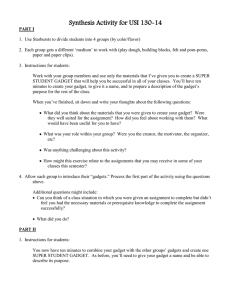
![[#BAM-1384] Error was thrown when creating gadget in](http://s3.studylib.net/store/data/008624423_1-6f089c8fcdd44b7b0c03215bf260bf0e-300x300.png)
